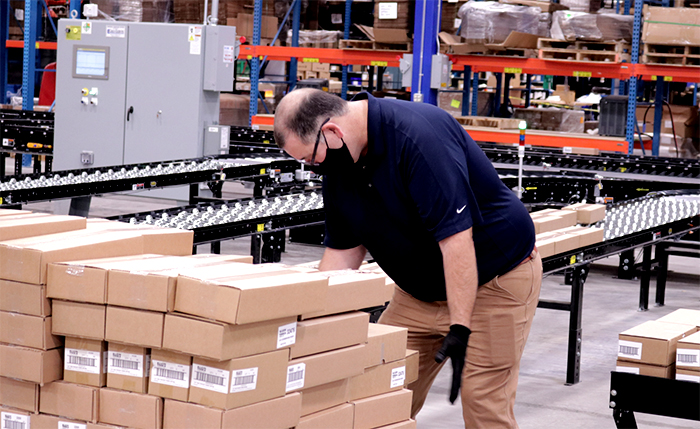Targeted Warehouse Automation: Manual Pallet Handling
Stacking and stretchwrapping pallet processes

While many companies can benefit from full scale automation, the math isn’t the same for everyone. However, labor shortages continue to drive companies to seek ways to reduce dependence on manual processes in specific, labor-intensive functions. What are some areas you should target for partial automation?
Handling, large, heavy pallets is problematic. Traditionally, companies have thrown more of the same kinds of manual resources at the issue—more forklifts, more people, more space. But it’s possible to work faster and use fewer resources with targeted automation.
Costs always matter
No getting around it: automation is expensive and time consuming. You should know that going into the process. Every customer we have built systems for recognized that it’s expensive and sometimes difficult to change. You will need to evaluate, document and refine processes. Planning commitments will be there. You will write checks. Those costs and that energy are all upfront, however. The payoff for automated systems used to rest primarily in reduced operating costs. These days, it may be necessary just to continue to operate in a restricted labor environment.
Meanwhile, ongoing operational costs—people, training, ongoing inefficiency—are rising quickly.
Palletizing is ideal for targeted automation

Above: manual carton stacking at the end of a conveyor line.
Manual palletizing is hard work—difficult, time-consuming and un-ergonomic. It often takes multiple people to stack, wrap and move a single pallet. Fortunately, the automation industry has zeroed in on palletizing because it also knows the business case for improving it. Some of the problems with manual palletizing include:
- Speed: since people are building pallets on the fly, it’s a needlessly slow process.
- Consistency: people may stack pallets in unstable ways, or in ways that cause damage.
- Injuries: the constant bending, stretching and stacking take a toll on people. It’s a job for the younger, stronger workers only.
- Production congestion: if you can’t palletize consistently, everything can slow or stop upstream of palletizing.
Cobot palletizing
Half a decade ago, the best solution was full-scale robotic palletizers or expensive layer machinery. These systems had extended planning and implementation windows, their extremely high costs aside. They’re still viable for the right kind of use case, but now there are solutions for less demanding applications. Due to the emergence of cobot palletizing systems that are far less expensive and can be deployed in a fraction of the time, this has shifted.
When your carton sizes and weights meet the profile, it’s an extremely efficient way to process pallets in a targeted manner.
Cobot palletizers take direct aim at a highly problematic part of the production process for targeted automation.
Stretch wrapping by hand is highly manual, unreliable and often slow

Building pallets isn’t the end of the process in most cases. You still need to wrap and ship them, and those are traditionally labor-intensive, difficult and slow processes. This is an area ripe with opportunities for partial automation because the equipment to do so is battle-tested and highly reliable.
Consider what has to happen to manually wrap a pallet:
- The pallet is stacked and transported to a stretch wrap area.
- Workers wrap the pallet securely in stretch film from top to bottom, meaning from 6 inches off the ground to potentially over their heads.
- Certain types of pallets/loads should be double-wrapped.
- The end of the wrap layer must be secured under a pallet edge.
- Loads should be tested for stability to ensure that cartons won’t shift during shipping or handling.
- The pallet should be transported to docks, staging areas and truck trailers.
Every step of this process is labor-intensive, often involving a forklift driver and people on the floor. Stretch wrapping frequently takes at least two people out of action in other areas several hours a day. This is a prime area for bottlenecks and ergonomic issues—and a prime target for partially automated systems.
Above: in this example, in a forklift-driven process, the driver is the only person involved in the stretch wrapping process. He delivers a stacked pallet to the stretch wrapper and triggers the machine without leaving his seat. The stretch wrapper then wraps the pallet free of human involvement. Once the the pallet is wrapped, the driver picks up the pallet and can deliver it to shipping docks. This would both take longer and be less reliable if executed by people on the ground.
Above: In this example, an automated stretch wrapper integrated into a conveyor line wraps pallets without human intervention. If your process and volume allow it, you can target every step in the process from the moment a carton reaches the end of an order picking line to pallet stacking to stretch wrapping to shipping with little or no labor involved.
Read more: Turntable and Rotary in full and semi-automated configurations
Pallet stacking and wrapping can be reliably automated—either in part or full
When it comes to pallet handling, every time you reduce human involvement, you create value and long-term return-on-investment because these are simple tasks that add limited value. You can re-task scarce labor for more complex, higher value work. The first step is to understand your current situation and the impact of partial automation by profiling your SKUs, shipping volume and labor needs.
More resources
- Ergonomics and Pallet Handling
- AGVs, AMRs, and Conveyors: Automated Product Transport Applications
- Choosing the Right Pallet Conveyor
Tags: labor, palletizing, ergonomics
Scott Stone is Cisco-Eagle's Vice President of Marketing with 35 years of experience in material handling, warehousing and industrial operations. His work is published in multiple industry journals an websites on a variety of warehousing topics. He writes about automation, warehousing, safety, manufacturing and other areas of concern for industrial operations and those who operate them.



